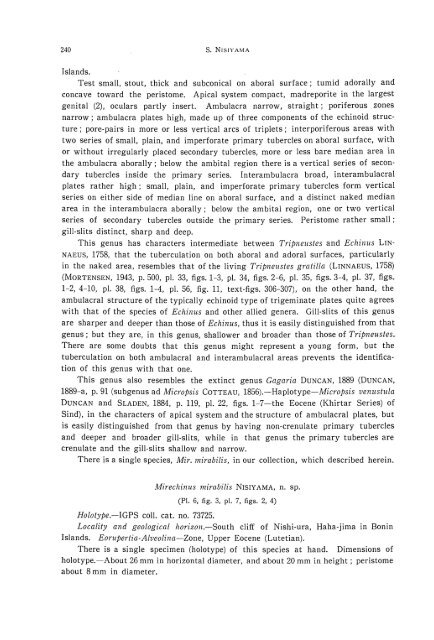the echinoid fauna from japan and adjacent regions part i
the echinoid fauna from japan and adjacent regions part i
the echinoid fauna from japan and adjacent regions part i
Create successful ePaper yourself
Turn your PDF publications into a flip-book with our unique Google optimized e-Paper software.
240 s. NISIYAMA<br />
Isl<strong>and</strong>s.<br />
Test small, stout, thick <strong>and</strong> subconical on aboral surface; tumid adorally <strong>and</strong><br />
concave toward <strong>the</strong> peristome. Apical system compact, madreporite in <strong>the</strong> largest<br />
genital (2), oculars <strong>part</strong>ly insert. Ambulacra narrow, straight; poriferous zones<br />
narrow; ambulacra plates high, made up of three components of <strong>the</strong> <strong>echinoid</strong> structure;<br />
pore-pairs in more or less vertical arcs of triplets; interporiferous areas with<br />
two series of small, plain, <strong>and</strong> imperforate primary tubercles on aboral surface, with<br />
or without irregularly placed secondary tubercles, more or less bare median area in<br />
<strong>the</strong> ambulacra aborally; below <strong>the</strong> ambital region <strong>the</strong>re is a vertical series of secondary<br />
tubercles inside <strong>the</strong> primary series. Interambulacra broad, interambulacral<br />
plates ra<strong>the</strong>r high; small, plain, <strong>and</strong> imperforate primary tubercles form vertical<br />
series on ei<strong>the</strong>r side of median line on aboral surface, <strong>and</strong> a distinct naked median<br />
area in <strong>the</strong> interambulacra aborally; below <strong>the</strong> ambital region, one or two vertical<br />
series of secondary tubercles outside <strong>the</strong> primary series. Peristome ra<strong>the</strong>r small ;<br />
gill-slits distinct, sharp <strong>and</strong> deep.<br />
This genus has characters intermediate between Tripneustes <strong>and</strong> Echinus LIN<br />
NAEUS, 1758, that <strong>the</strong> tuberculation on both aboral <strong>and</strong> adoral surfaces, <strong>part</strong>icularly<br />
in <strong>the</strong> naked area, resembles that of <strong>the</strong> living Tripnellstes gratifla (LINNAEUS, 1758)<br />
(MORTENSEN, 1943, p. 500, pL 33, figs. 1-3, pI. 34, figs. 2-6, pI. 35, figs. 3-4, pI. 37, figs_<br />
1-2, 4-10, pI. 38, figs. 1-4, pI. 56, fig. 11, text-figs. 306-307), on <strong>the</strong> o<strong>the</strong>r h<strong>and</strong>, <strong>the</strong><br />
ambulacral structure of <strong>the</strong> typically <strong>echinoid</strong> type of trigeminate plates quite agrees<br />
with that of <strong>the</strong> species of Echinus <strong>and</strong> o<strong>the</strong>r allied genera. Gill-slits of this genus<br />
are sharper <strong>and</strong> deeper than those of Echinus, thus it is easily distinguished <strong>from</strong> that<br />
genus; but <strong>the</strong>y are, in this genus, shallower <strong>and</strong> broader than those of Tripneustes_<br />
There are some doubts that this genus might represent a young form, but <strong>the</strong><br />
tuberculation on both ambulacral <strong>and</strong> interambulacral areas prevents <strong>the</strong> identification<br />
of this genus with that one.<br />
This genus also resembles <strong>the</strong> extinct genus Gagaria DUNCAN, 1889 (DUNCAN,<br />
1889-a, p. 91 (subgenus ad Micropsis COTTEAU, 1856).-Haplotype-Micropsis venustula<br />
DUNCAN <strong>and</strong> SLADEN, 1884, p. 119, pI. 22, figs. 1-7-<strong>the</strong> Eocene (Khirtar Series) of<br />
Sind), in <strong>the</strong> characters of apical system <strong>and</strong> <strong>the</strong> structure of ambulacral plates, but<br />
is easily distinguished <strong>from</strong> that genus by having non-crenulate primary tubercles<br />
<strong>and</strong> deeper <strong>and</strong> broader gill-slits, while in that genus <strong>the</strong> primary tubercles are<br />
crenulate <strong>and</strong> <strong>the</strong> gill-slits shallow <strong>and</strong> narrow.<br />
There is a single species, Mil'. mirabilis, in our collection, which described herein_<br />
Mirechinus mirabilis NISIY AMA, n. sp.<br />
(PI. 6, fig. 3, pI. 7, figs. 2, 4)<br />
Holotype.-IGPS colI. cat. no. 73725.<br />
Locality <strong>and</strong> geological horizon.-South cliff of Nishi-ura, Haha-jima in Bonin<br />
Isl<strong>and</strong>s. Eorupertia-Alveolina-Zone, Upper Eocene (Lutetian).<br />
There is a single specimen (holotype) of this species at h<strong>and</strong>. Dimensions of<br />
holotype.-About 26 mm in horizontal diameter, <strong>and</strong> about 20 mm in height; peristome<br />
about 8 mm in diameter.












